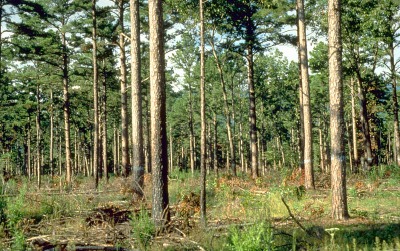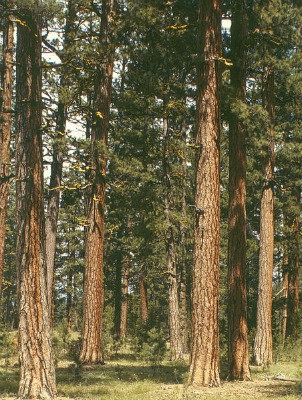As with agricultural plants, forest trees compete for moisture and sunlight. Farmers have strategies for addressing this issue. They can reduce moisture stress by using irrigation and control access to sunlight by regulating row spacing. Forest owners, on the other hand, cannot use these methods. Providing supplemental water usually is not practical for forests, and young forest trees often are too close together to obtain the sunlight needed to allow for good growth as they age. Consequently, forest owners commonly use the strategy of thinning, or removing trees from a forest.
Types of Thinnings
Thinning treatments can be broadly categorized as precommercial or commercial. In a precommercial thinning, trees too small to be made into wood products are cut from the forest. In a commercial thinning, trees large enough to be made into boards are removed.
Results of Thinning
Forest owners thin their stands to achieve a variety of results. Primarily, thinning improves tree health by increasing the space between trees and reducing the number of trees competing for the same amounts of moisture, sunlight, and nutrients.
Another chief benefit of thinning is improved species composition. When combined with reducing stand density, improved species composition can lead to healthier trees and thus a forest that is more resilient to stressors over time. Many landowners strive for a mix of tree species that will be most resilient and adaptable to the varying drought, insect, and disease cycles the stand is likely to experience over the long term. To some degree, favoring a mix of several tree species (rather than just one or two species) reasonably adapted to the site provides more flexibility for future conditions.
Moreover, forest owners sometimes thin their stands to reduce the risk of damaging wildfire. Such thinnings are especially important when the trees are near buildings and other structures.
In addition to reducing competition, improving species composition, and lessening the risk of damage from fire, thinnings can

-
concentrate growth on fewer trees, thereby increasing their value;
-
remove suppressed or undesirable trees;
-
enhance wildlife habitat, provide grazing options, increase recreational opportunities, improve hydrology, and produce other nontimber benefits;
-
improve stand genetics (if the tallest, best formed trees are favored and later provide natural seeding on the site);
-
decrease the length of time to a planned harvest;
-
allow for the use of trees that might otherwise decay; and
-
produce income (if trees removed are large enough to sell).

Thinning Considerations
When planning thinning treatments, landowners must take into account a variety of factors. Two important considerations are the geographic location of the forest and the desired forest density.
Consideration of Geographic Location
Many eastern forests started growing after lands were abandoned from agricultural production in the late 1800s and early 1900s. In some cases, these forests started with tens of thousands of seedlings per acre; the mature eastern forest might have 150 to 250 trees per acre. In eastern forests, thinning can be used to control species composition, encourage faster growth on the best quality stems, and ensure trees that are vigorous and better able to respond to the variety of stressors that occur.
In the western United States, many drier forest sites have many more fir trees now than in the past due to fire exclusion and partial harvest practices that favor shade-tolerant species. Ponderosa pines typically are more resilient to insects, disease, and drought over the long term on such sites. With a thinning, therefore, a landowner might adjust species composition from 80 percent fir and 20 percent pine to 70 percent pine and 30 percent fir and, as a result, achieve a corresponding reduction in the risk of trees dying from insect infestation, root disease, or fire.
Consideration of Ideal Forest Density
Forest density is the number of trees per acre. Thinning can be used to produce a wide variety of forest densities. For example, when thinning sapling-sized trees, spacing between trees is commonly 12 to 15 feet. Progressively more space is left between larger forest trees. One way to think about thinning is to consider carrying capacity. Foresters typically try to keep a forest’s density at 35 to 60 percent of the maximum possible carrying capacity, depending on the tree species and a variety of other factors. For example, a landowner who wants more sunlight to reach the forest floor to stimulate understory plants for wildlife might thin a little more heavily (though doing so can increase understory fire risk).
Conclusion
Thinning isn’t the solution to every forest management issue, but it is frequently indispensable. Changing forest density and species composition is the heart of silviculture, which is based on a working understanding of forest ecology. Forest ecology and silviculture vary significantly from region to region in the United States, so forest owners may wish to consult a local forester to learn more about tree species, insects and diseases, and other ecological considerations that should be integrated into thinning efforts for a particular property.
The following articles provide more information about thinning of forests and woodlands:
- Natural Thinning in Forests and Woodlands
- Addressing Slash from Forest Thinning Treatments
- Paying for Forest Thinning Treatments
- Thinning Forests to Reduce Risks from Wildfires
Contributors
Chris Schnepf, University of Idaho, and Kristi Sullivan, Cornell University
For More Information
Bennett, Max, Stephen Fitzgerald, Bob Parker, Marty Main, Andy Perleberg, Chris Schnepf, and Ron Mahoney, 2010. Reducing Fire Risk on Your Forest Property. Pacific Northwest Extension Publication PNW 618.
Emmingham, W.H., and N.E. Elwood, 1983. Thinning: An Important Timber Management Tool. Pacific Northwest Extension Publication PNW 184.
McKenna, James, and Keith Woeste, 2000–2014. Planting and Care of Fine Hardwood Seedlings: Fertilizing, Pruning and Thinning Hardwood Plantations. Series of 20+ publications on caring for hardwoods available at: http://www.agriculture.purdue.edu/fnr/htirc/publications/landowners.html.
Schnepf, Chris, Russell T. Graham, Sandy Kegley, and Theresa B. Jain, 2009. Managing Organic Debris for Forest Health: Reconciling Fire Hazard, Bark Beetles, Wildlife and Forest Nutrition Needs. Pacific Northwest Extension Publication PNW 609.
